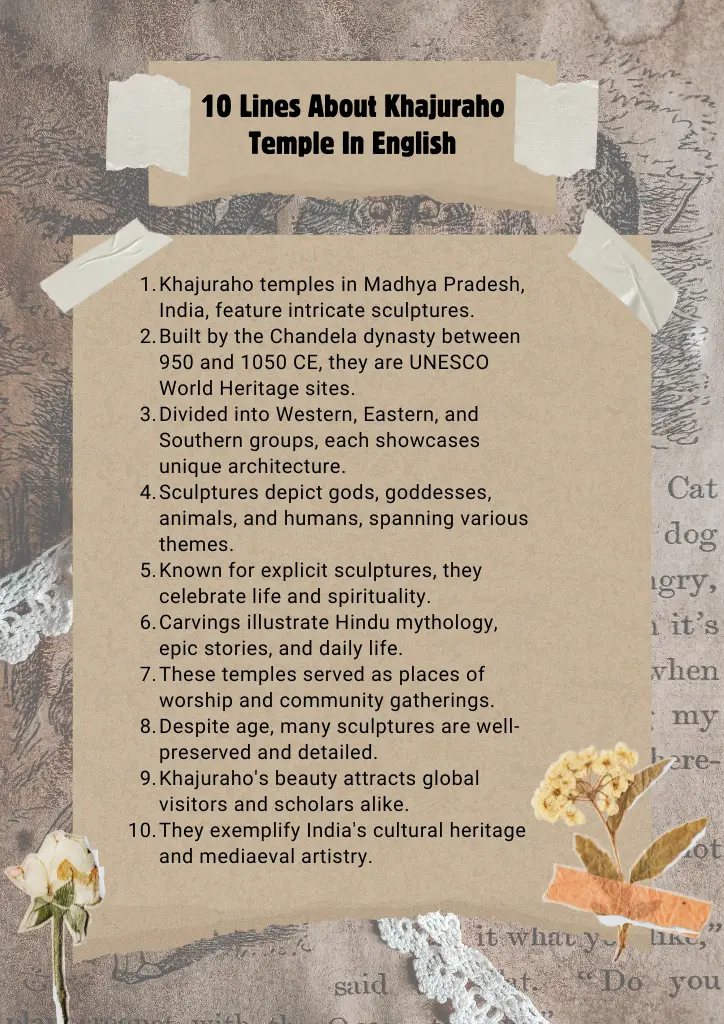Khajuraho temples, a UNESCO World Heritage site, are renowned for their intricate sculptures and architectural brilliance. These temples, built between 950 and 1050 CE by the Chandela dynasty, are a testament to India’s rich cultural and artistic heritage. Known for their stunning erotic sculptures, Khajuraho temples also depict scenes from everyday life, mythology, and spiritual teachings. Today, we delve into these remarkable temples through a concise exploration of their history, artistry, and cultural significance in 10 lines about Khajuraho temple. Join us on a journey to uncover the allure and legacy of Khajuraho’s architectural marvels.
10 Lines About Khajuraho Temple In English
- Khajuraho temples in Madhya Pradesh, India, feature intricate sculptures.
- Built by the Chandela dynasty between 950 and 1050 CE, they are UNESCO World Heritage sites.
- Divided into Western, Eastern, and Southern groups, each showcases unique architecture.
- Sculptures depict gods, goddesses, animals, and humans, spanning various themes.
- Known for explicit sculptures, they celebrate life and spirituality.
- Carvings illustrate Hindu mythology, epic stories, and daily life.
- These temples served as places of worship and community gatherings.
- Despite age, many sculptures are well-preserved and detailed.
- Khajuraho’s beauty attracts global visitors and scholars alike.
- They exemplify India’s cultural heritage and mediaeval artistry.

Essay On Khajuraho Temple In 300 Words
The Khajuraho Temples, situated in Madhya Pradesh, India, represent an extraordinary testament to the architectural and artistic brilliance of the Chandela dynasty. Built between 950 and 1050 CE, these temples have been designated as UNESCO World Heritage sites, drawing global admiration for their intricate sculptures and exquisite craftsmanship.
The temples are grouped into Western, Eastern, and Southern complexes, each characterised by unique architectural styles that blend seamlessly with their natural surroundings. The Western group, in particular, showcases the largest and most iconic temples, including the Kandariya Mahadeva Temple, known for its towering spires and elaborate sculptures.
Khajuraho’s sculptures are a hallmark of its artistic heritage, depicting a diverse range of subjects. From celestial beings, gods, and goddesses to animals and intricate human forms, the sculptures narrate stories from Hindu mythology, depict daily life activities, and symbolise spiritual teachings. Notably, the temples are renowned for their explicit and meticulously detailed erotic sculptures, which celebrate love, passion, and the union of spiritual and physical realms.
Despite centuries of exposure to the elements, many of Khajuraho’s sculptures remain remarkably well-preserved, retaining their intricate details and artistic finesse. These sculptures, carved on temple walls and pillars, not only serve as artistic marvels but also provide insights into the cultural and religious practices of mediaeval India.
Khajuraho temples served as important centres of worship and community gatherings during their prime, fostering cultural exchange and religious practices among devotees. Today, they continue to attract visitors, scholars, and art enthusiasts from around the world, who marvel at their architectural splendour and artistic mastery.
In conclusion, the Khajuraho Temples stand as a symbol of India’s rich cultural heritage and artistic excellence. Through their intricate sculptures and architectural grandeur, they offer a glimpse into the vibrant history and spiritual ethos of mediaeval India, captivating the imagination and admiration of all who visit them.
Timeline of Khajuraho Temple
- 950-1050 CE: Construction of Khajuraho Temples by the Chandela dynasty.
- Mediaeval Period: Flourished as centres of religious worship and cultural exchange.
- Centuries: Faced challenges from weathering, neglect, and environmental factors.
- 19th Century: Rediscovered by British surveyors, sparking global interest.
- 1986: Designated as UNESCO World Heritage sites for their cultural significance.
- Present: Continues to attract visitors and scholars worldwide, contributing to India’s cultural heritage appreciation.
| Also Read: 10 Lines On Abdul Kalam In English |
Essay On Khajuraho Temple In 700 Words
The Khajuraho Temples, nestled in the heart of Madhya Pradesh, India, are not just architectural wonders but profound testaments to the artistic ingenuity and cultural richness of ancient India. Built between 950 and 1050 CE by the Chandela dynasty, these temples have earned global acclaim and UNESCO World Heritage status for their exceptional sculptures and intricate architectural designs.
Historical Context and Architectural Splendor
The Khajuraho Temples are divided into three main groups: Western, Eastern, and Southern. Each group features a stunning array of temples adorned with elaborate sculptures and intricate carvings. The Western group, comprising the largest and most significant temples like the Kandariya Mahadeva Temple, stands out with its towering spires, intricately carved panels, and detailed sculptures of deities, celestial beings, and mythological figures.
These temples were not only places of worship but also centres of cultural and spiritual exchange during the height of the Chandela dynasty. The architectural layout and sculptures depict a blend of Hindu, Jain, and Aryan influences, showcasing the diversity and inclusivity of religious practices during mediaeval India.
Artistic Masterpieces: Sculptures and Carvings
One of the most remarkable features of Khajuraho Temples is their exquisite sculptures. The temples’ walls and pillars are adorned with thousands of sculptures that depict a wide range of subjects, including gods, goddesses, mythical creatures, animals, and intricate human forms engaged in various activities. These sculptures serve not only as decorative elements but also as vehicles for storytelling and spiritual teachings, illustrating scenes from Hindu epics like the Ramayana and Mahabharata.
Among the most famous sculptures at Khajuraho are the intricate and explicit erotic sculptures that adorn the temple walls. Contrary to popular misconception, these sculptures are not solely focused on eroticism but are symbolic representations of the union between spiritual and physical realms, celebrating human emotions and the pursuit of divine bliss.
Cultural Significance and Heritage Conservation
The preservation of Khajuraho Temples is vital for understanding India’s cultural heritage and artistic achievements. Over the centuries, these temples have faced numerous challenges, including environmental factors, vandalism, and neglect. However, efforts by archaeological departments and conservationists have ensured that these architectural marvels continue to inspire awe and admiration.
Conservation efforts have focused on stabilising temple structures, restoring damaged sculptures, and implementing sustainable tourism practices to minimise environmental impact. Educational initiatives and guided tours help visitors appreciate the historical and cultural significance of Khajuraho, fostering a deeper understanding of India’s rich past and architectural legacy.
Tourism and Global Recognition
Khajuraho Temples attract tourists, scholars, and art enthusiasts from around the world, drawn by their architectural grandeur and artistic finesse. The temples’ inclusion on the UNESCO World Heritage list has enhanced their global recognition, highlighting their significance as cultural landmarks and centres of artistic excellence.
Tourism plays a significant role in the economic development of the region surrounding Khajuraho, providing employment opportunities and promoting local handicrafts and cuisine. However, sustainable tourism practices are essential to ensure that the influx of visitors does not compromise the integrity and preservation of these ancient temples.
Cultural Continuity and Spiritual Legacy
The Khajuraho Temples continue to serve as active centres of religious worship for local communities, particularly during festivals and auspicious occasions. Devotees visit these sacred sites to offer prayers and seek blessings, reinforcing the temples’ role as spiritual hubs that connect past traditions with contemporary practices. The ongoing rituals and ceremonies at Khajuraho underscore the enduring spiritual significance of these ancient monuments in modern Indian society.
Conservation Challenges and Future Prospects
Despite concerted conservation efforts, the Khajuraho Temples face ongoing challenges, including environmental degradation, weathering of delicate sculptures, and the pressures of tourism. Balancing preservation with accessibility remains a critical endeavour to ensure that future generations can continue to appreciate these architectural marvels. Sustainable tourism practices, community involvement in conservation efforts, and technological advancements in heritage preservation are essential strategies for safeguarding Khajuraho’s cultural legacy.
In conclusion, the Khajuraho Temples stand as enduring symbols of India’s cultural heritage and architectural prowess. Through their exquisite sculptures, intricate carvings, and historical significance, these temples offer a window into the artistic achievements and religious practices of mediaeval India. By preserving and protecting Khajuraho Temples, we not only safeguard our cultural legacy but also celebrate the diversity and artistic brilliance that define India’s identity. Let us continue to cherish and uphold these architectural marvels for future generations to marvel at and appreciate.
Conclusion
Khajuraho Temples, renowned for their intricate sculptures and cultural significance, exemplify India’s architectural splendour and spiritual depth. Today, we explored this UNESCO World Heritage sites through essays and 10 lines about Khajuraho Temple
highlighting their historical richness and artistic mastery. Preserving these temples is vital to safeguarding our cultural legacy and inspiring future generations with their profound beauty and spiritual symbolism. Let us cherish Khajuraho Temples as enduring symbols of India’s artistic and spiritual heritage, ensuring they continue to captivate and educate visitors from around the world.

